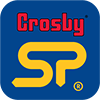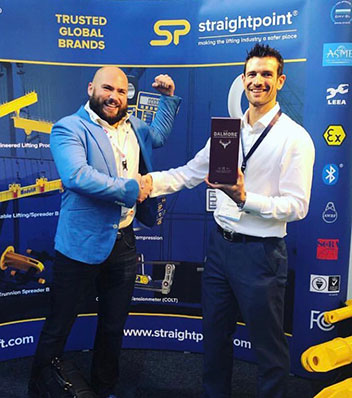Standing in for Mr. Loadlink, David Mullard, business development manager at Straightpoint, talks tactics.

The Mr Loadlink briefcase
I knew the look. He approached me like this once before back in the UK spring of 2016.
Straightpoint (SP) director David Ayling, aka Mr. Loadlink, hugged the wall of the corridor as though to stay out of view. It didn’t work. By the time he arrived at my desk, small briefcase under arm, I knew what he was going to ask.
“Dave…”
“I’d be honoured,” I interrupted.
Mr. Loadlink looked perplexed that before he’d even asked if I’d be happy to pen another guest blog, I’d gleefully accepted the invitation. Truth is, since he asked the first time, I’ve kept a mental note while on my travels to make sure I’m always prepared to share my experiences should the need arise—even as I descend upon the Liverpool Exhibition Centre for this year’s Speedy Expo.
With Mr. Loadlink called away, here goes in the shape of three tips for successful business development.
1. Become the lord of the rings
Don’t worry; this isn’t a trip to Middle-earth. Far from it. But it is my lead point in something of a trilogy.
In the here and now, it’s important to place oneself in as many relevant communities as possible. I call them circles. They can be of all different sizes, some overlap, and the number of circles in an individual’s career should be ever increasing, within reason. A circle can capture an end user marketplace, an area of technology, a geographical region, a group of professionals, or something else.

Everyone’s circle map will look different.
I work at a company that manufactures a diverse product that can be used underground, offshore, at height, on the highway, and on the airfield. And that’s just a small sample. It means my map of circles is vast in number. Some are small. Someone else’s might look more like the Olympic rings, while another person may have only two or three circles to work within. It doesn’t matter; what’s really important is that they’re clearly defined (a circle is a simple closed shape) and they’re entered with authenticity and a long-term commitment.
I’ve recently been spending time in my offshore wind energy and marine circles, for example. Both are important marketplaces for SP equipment. Activity surrounding the International Marine Contractors Association (IMCA)—it organises a regular programme of meetings and events all over the world—forms an important circle to me. One could argue it’s part of the larger marine ring, but I don’t want to overcomplicate the theory. Each of these events might address a different audience and work to varied objectives.
Mullard the mariner
Recently, I was invited to speak to an IMCA delegation about using load cells in marine applications. Delivering such presentations is a great way to raise a profile within a circle and build a reputation as a thought leader. It’s about being a marine force measurement expert here, not just a load cell guy. This isn’t an article about presenting but it’s worth stressing the importance of not abusing such opportunities by making sales pitches. One could be evicted from a ring (over the top rope) pretty quickly if they don’t adhere to the codes and practices at play.

It’s important to immerse oneself in different business communities
The Lifting Equipment Engineers Association (LEEA) technical committees presently form another key circle for me. Readers of this article outside of the lifting industry will no doubt have similar trade associations and working groups relevant to their sectors. It’s hugely rewarding to contribute to such work and, again, providing these activities are entered in the right spirit, peers are generally appreciative of everyone’s participation.
Judging when a long game becomes a fool’s errand is down to an individual’s interpretation. All circles should be given a chance (perseverance wins, usually), but if the only action is drinking coffee and talking about football, it might not be worth the air fare. Don’t judge them by direct sales—that’s crude—but look for progress and improvement of an individual, company, or industry. LEEA’s sub-committees have helped to build a substantial library containing 40+ guidance documents covering a wide variety of topics, for instance. As a business we’ll profit in the long term by continued improvement of best practices and elevated standards, which is essentially the association’s ethos—and ours.
2. Be solution centric
In other words, have the answers. Think about what an existing or prospective customer spends a lot of their time doing—seeking ways to solve problems. They might want to be better, faster, safer, or more diverse, and the quest for such advancement will generate questions. They’ll hit obstacles, junctions in the road, and maybe even stumble into quicksand. It’s advisable for any service provider, therefore, to present himself or herself as a problem solver. Ask yourself: what can my company do to make a customer’s life easier?

Become a problem solver.
Whether it’s here at the Speedy Expo, at last week’s Offshore Energy Exhibition & Conference (OEEC), or the upcoming LiftEx, I consider the audience within the circle and try to find out as much information as possible that will help me solve problems. It’s not a lone effort, of course. Everyone at SP has the same mentality; we constantly gather intelligence and feed it back to ensure all of our new products and enhancements are actually solutions. It’s incredibly rewarding to return to a customer and be able to remind them of a previous conversation about an ongoing dilemma, and then pull the solution out of the bag.
Becoming solution centric takes a certain state of mind, however. Regular blogger Mr. Loadlink talks a lot about SP DNA, and I know what he means. We’re active problem solvers because company culture is to be positive; we’re the ‘can-do’ people versus the ‘that’s not really what we do’ folks. Try solving a problem without the right attitude. It’s impossible.
3. Have fun
No circle will become magic or solution emerge if one isn’t having fun in the process. Marc Anthony is credited for saying, “If you do what you love, you’ll never work a day in your life,” and many a successful person has paraphrased the adage since. There’s a lot of truth in it. A marathon runner could never motivate him or herself to train on cold, winter mornings if they didn’t get some pleasure from it or at least experience a great buzz or rush on race days. Crossing the finish line might be the greatest feeling in the world to them, so it’s worth training for.
Look around a trade show (or circle) and it’s obvious who is enjoying the experience versus those who are there because they have to be. Mr. Loadlink has already covered trade show strategy and etiquette extensively so no need for me to duplicate his content, but suffice it to say a smile will get one further than a scowl every day of the week.
- Do you gravitate towards calmness or confrontation?
- Enjoyment or depression?
- Problem or solution?
Take the aforementioned OEEC, which took place in Amsterdam on 22-24 October, as an example. We repeated our “strongest visitor” competition, where we test the physical prowess of an attendee by machining handles onto a Bluetooth-enabled Radiolink plus load cell and inviting them to pull with all their might.
- The OEEC prizes were worth winning
- Strong man Sean Zevenbergen was a worthy winner
There’s a serious point to the product but this is a fun and interactive way of demonstrating its capability versus hanging it on a rack at the back of the exhibit in front of a big pop-up banner. We thought 44kg was an impressive pull—good enough to take home a bottle of malt whiskey on the first
day—but Sean Zevenbergen, who regularly bench-presses my bodyweight, apparently, ripped over 70kg 24 hours later.
I hope participants at the Speedy show are warming up their muscles!
Thank you for reading.
Dave Mullard
Business Development Manager, Straightpoint
dmullard@straightpoint.com

You weren’t missing him, were you? Just in case, here’s a photo of Mr. Loadlink, a man with an impressive circle map of his own, presenting another solution to a customer, and having fun doing it. He’ll be back next month.








